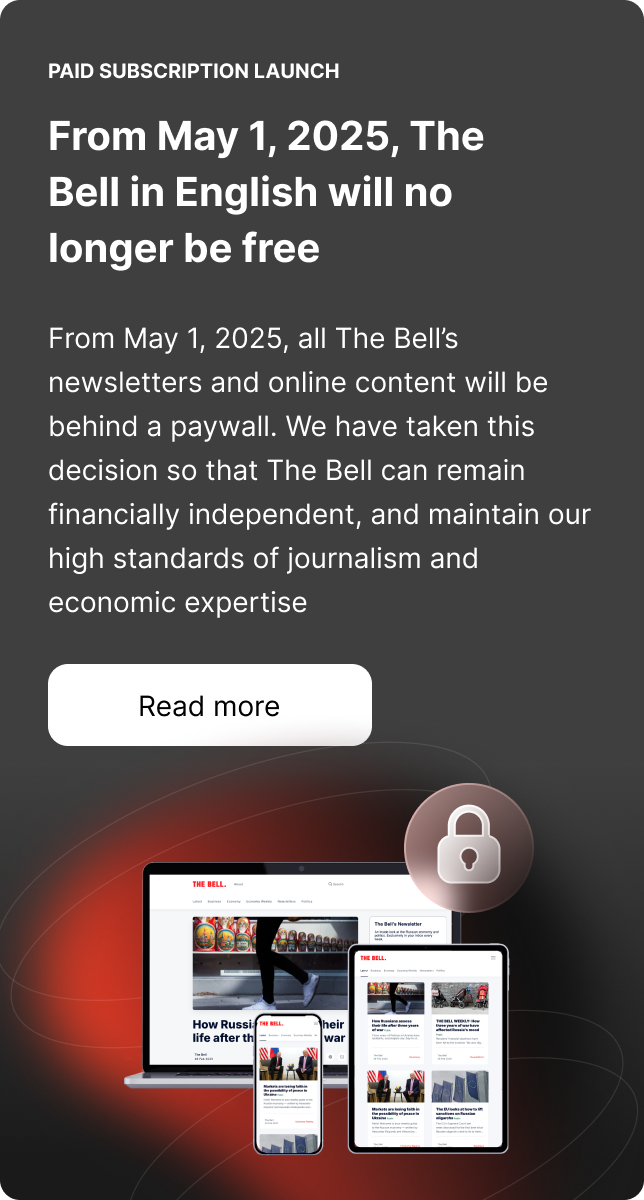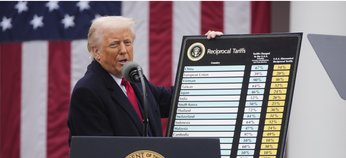
Could a global trade war destabilize Russia’s finances?
Hello! Welcome to your weekly guide to the Russian economy — written by Alexandra Prokopenko and Alexander Kolyandr and brought to you by The Bell. This week we look at what the effect of a prolonged trade war and lower oil prices would be on the Russian economy. We also examine why a trade war might make it more likely that Europe would permanently confiscate €200 of frozen Russian state assets.
Before we begin, though, a brief note from one of your authors, Alexandra Prokopenko:

I have been analyzing the Russian economy for 20 years, but I believe my work is more important now than ever. Russia is waging a major war in the center of Europe and trying to refashion the world order. Donald Trump has started a trade war against China, reshaping global trade. There will be no winners. But how will these things affect the Russian economy? Does Putin have enough money to continue waging war? Are sanctions working? Could fear of economic collapse force him to make concessions? A nuanced understanding of the Russian economy helps navigate this complicated puzzle.
From the beginning, our newsletter was designed to spotlight facts and figures, not ideological convictions and flashy headlines. While some commentators predicted Russia would collapse, we were analyzing the data and explaining why it was not that simple.
On May 1, The Bell in English will go behind a paywall. Such a decision is always a difficult one for authors and publishers, but expertise costs money, and we believe it’s the right choice. As a reader of our newsletter you can subscribe 20% less than even the cheapest option available via our website. I very much hope that you will opt to subscribe in order to continue reading – and enjoying – our analysis of the Russian economy.
Russia’s economic managers grapple with Trump tariff challenge
Even though Russia was not targeted by United States President Donald Trump’s tariffs, Moscow is readying itself to deal with the fallout from a trade war. Central Bank head Elvira Nabiullina described Wednesday the recent changes in world trade as a “significant risk.” Tit-for-tat tariffs could slow the global economy and, as a consequence, reduce demand for Russian oil. But does this threaten Russia’s financial stability?
Oil price tumble
A combination of Trump’s tariffs, fears of a global economic slowdown, and an unexpected reversal in the pricing policy of cartel OPEC+ have led to an oil price plunge. The price of a barrel of Brent crude fell from $75 on April 1 to $59 on Wednesday, its lowest level for four years. On Friday, the United States Department for Energy lowered its forecast for the average price of Brent in 2025 from $74.20 to $67.87. Of course, the war in Ukraine and Western sanctions mean Russian oil typically sells for about $10 cheaper than Brent.

The drop in oil prices came after the U.S. and China appeared to be entering a major trade war. Trump introduced tariffs on dozens of countries last week, before announcing a 90-day pause. The only country not covered by the pause was China, which must now pay 104% tariffs on goods going into the United States. In response, China hiked Friday the equivalent tariffs on American goods to 125%. It was also fuelled by the decision of OPEC+ to ramp up oil production faster than expected, raising the prospect of an oil supply glut.
Planning for a crisis
Russia’s economic managers were not caught off guard by the development. In fact, the Central Bank last year floated the possibility of a fall in oil prices and greater fragmentation of the global economy. This scenario, outlined in the Bank of Russia's Guidelines for the Single State Monetary Policy in Autumn 2024, involved increased deglobalization amid deteriorating relations between the U.S. and China and a fall in oil prices to $50 a barrel or less. The resulting global economic crisis, the bank said, could be similar in scale to 2008 (when global GDP fell by 1.3%).

In such a scenario, the Russian government would be forced to burn through even more reserves from the National Welfare Fund (NWF). “At this rate of spending there is a risk of exhausting the NWF’s liquid assets as early as 2025,” the Central Bank cautioned.
Meanwhile, a trade war significantly increases the risk of U.S. dollar inflation, and therefore of higher U.S. interest rates. Combined with reduced revenue from oil-and-gas exports, this could make it harder for the Central Bank to reduce interest rates in Russia: in simple terms, high borrowing costs would likely be here to stay. That means it would be more expensive for the Finance Ministry to cover the budget deficit, which could further slow economic growth. This year’s growth rate is already expected to be half that of 2024.
Mild risks
Oil-and-gas revenues make up about a third of all the money collected by the Russian state. This year, the Finance Ministry was expecting to get 10.94 trillion rubles of oil-and-gas revenues at an average price of $69.7 for a barrel of Russian oil and an average U.S. dollar rate of 96.5 rubles. But it has not once hit its monthly targets this year: according to the Economic Development Ministry, a barrel of Urals crude cost $67.7 in January, $61.7 in February, and $59 in March. Further falls are likely this month.
A strengthening ruble is also adding to pressure on the budget. Since mid-February a U.S. dollar has been worth under 90 rubles, reacting weakly to a decrease in foreign currency earnings for exporters. This, in turn, is likely a sign of reduced demand, and fewer imports.
The Finance Ministry has warned that if oil prices stay below $60, the budget deficit will exceed the planned level of 0.5% GDP. To make up the difference, the government, as in previous years, is likely to look to the NWF. That would be an unpleasant surprise. When planning the current budget, the Finance Ministry assumed a more favorable macroeconomic situation, and did not foresee needing to raid the NWF to cover the deficit.
However, the risks do not yet appear significant. Budget revenues in the first three months of this year hit 9.05 trillion rubles, with expenditure at 11.2 trillion rubles. That’s a 2.2 trillion ruble deficit – or 1% of GDP. However, in March the budget closed with a surplus of 0.53 trillion rubles. This suggests high expenditure at the start of the year, due to placing advances (read more about this here), are returning to normal levels. Non-Oil and gas revenues are increasing – in the first three months of this year they were up 11% year-on-year – in line with the Finance Ministry’s plan (growth of 13.7% to 29 trillion rubles by the year’s end).
Ultimately, the pressure on Russia’s finances this year will depend on the global economy. In its baseline scenario, Russia assumes a moderate slowdown in global economic growth (including a Chinese slowdown to 4% a year in line with forecasts from top investment banks), and a fall in oil prices to $65.50 a barrel by 2027.
If the world economy escapes recession, however, the average annual oil price will likely rise. That would mean only a moderate deviation from the Finance Ministry’s base case scenario, and a significantly easier ride for Russia’s economic managers. And even if the world continues down the road towards crisis, Russia does have options. As oil prices fall, so does the market discount on Russian oil, which can partly compensate. In addition, a global crisis could reduce international support for Ukraine – a long-standing Kremlin goal.
Why the world should care
Right now, it is hard to predict what damage Russia might sustain from a trade war since there are so many uncertainties. That level of uncertainty is reflected in highly volatile markets and oil prices. But it’s important to remember that today’s oil price is less important to the Russian economy than where the oil price settles after the current turbulence. If prices do end up moving as suggested by the Central Bank in its forecast last year, then Russia’s budget will exhaust its reserves this year – making reductions to government spending inevitable. But, if average annual oil prices hover around $60 a barrel, then Russia should be able to survive relatively unscathed. In any case, the 2026 budget is awaiting spending consolidation.
How a trade war might affect Russia’s €200 billion in frozen assets
Earlier this year, the dispute between Trump and the EU over Ukraine has breathed new life into the idea of permanently confiscating the €200 billion worth of Russian Central Bank assets that were frozen in Europe after the full-scale invasion. And a trade war increases the likelihood this difficult decision will be taken.
- The European Commission last week received €2.1 billion in earnings from Russian Central Bank assets that are frozen in European accounts. This is income from managing these assets in the second half of last year. In the first half of the year, the earnings were €1.5 billion. While the assets themselves remain frozen, the revenues they generate are used to support Ukraine.
- Since the full-scale invasion of Ukraine, Western companies have debated the possibility of going further and seizing sovereign Russian assets – and using them to help Ukraine. This discussion, which had quietened down in recent months, was revived earlier this year when Trump briefly halted aid to Ukraine. Now, it looks possible that Trump’s trade war and the lack of clear progress in U.S. negotiations with Russia and Ukraine could make the case for confiscation. If the trade war pushes Europe into recession, there will be less money to help Ukraine and louder calls to grab Russian assets. Moreover, unpredictable U.S. trade policy means there is less concern that confiscation would undermine confidence in the euro.
- The United Kingdom, along with other countries in Northern and Central Europe, have long supported confiscation. Recently they have been joined by Spain and, partially, France. In mid-March the French parliament adopted a non-binding resolution urging the seizure of Russia’s sovereign assets.
- The Belgian government, however, is opposed to confiscation, largely because most of the frozen assets are held in its Euroclear depositary. It calls the proposed seizure an “act of war” that would threaten financial stability because it would mean investors were reluctant to trust the euro and the EU.
Why the world should care
The heightened risk of the EU – and perhaps other countries – seizing Russian assets is yet another consequence of Trump’s trade war. Russia’s Central Bank would not be affected - the money in question has been out of reach for three years already. However, it would make it less likely that European assets held in Russia would ever be released.
Figures of the week
Prices in Russia rose by 0.65% in March 2025, according to Rosstat. This is less than in February (0.81%) and January (1.23%), but in annual terms inflation still accelerated to 10.34% — higher than in February (10.06%). By the end of the year, the Bank of Russia expects inflation to fall to 7-8%.
The U.S. Department of Agriculture lowered its forecast for Russian wheat exports by 1 million tons to 44 million for the current agricultural year (July 2024 to June 2025). The estimate for Russia’s wheat harvest remains at 81.6 million tons.
Russia’s gold and foreign exchange reserves set a new record, increasing 1.9% in a week to $658 billion. The Central Bank said that the main reason for the jump was a revaluation due to changes in prices for gold and foreign currencies. Even though $300 billion of this is held in frozen accounts in Western banks, it’s still counted by the Central Bank.
Further reading
Down But Not Out: The Russian Economy Under Western Sanctions
The municipal reform and political power in Russia
Transatlantic Split Over Russia Leaves Japan Between a Rock and a Hard Place
Rewarding Russian Aggression Would Send Shockwaves Across Eurasia



PAID SUBSCRIPTION LAUNCH
From May 1, 2025, The Bell in English will no longer be free
From May 1, 2025, all The Bell’s newsletters and online content will be behind a paywall. We have taken this decision so that The Bell can remain financially independent, and maintain our high standards of journalism and economic expertise








